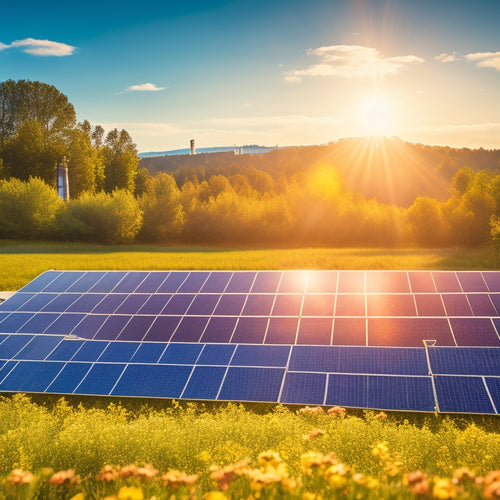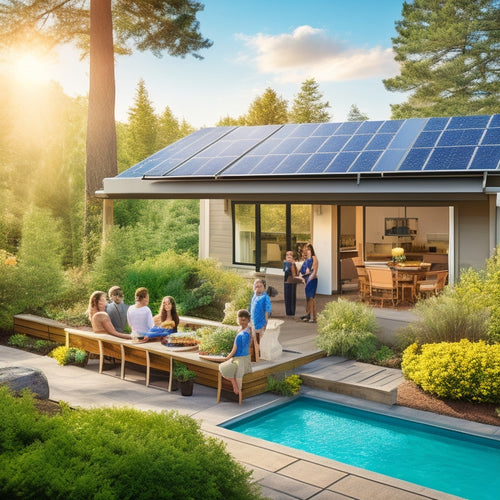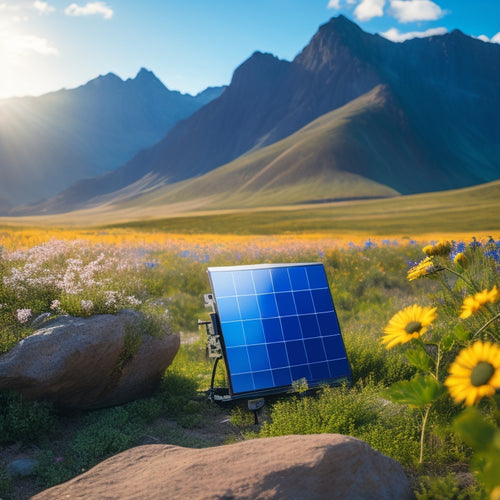
Achieve Home Energy Independence With Simple Hacks
Share
You're likely one of the 80% of homeowners who have no idea how much energy your home is wasting, which is why achieving energy independence starts with understanding your energy usage. Begin by monitoring your energy consumption with smart plugs and devices, and implement smart home automation to control lighting and appliances. Next, consider solar power and energy storage solutions to reduce your reliance on the grid. Conduct a DIY energy audit to identify areas for improvement, and optimize your home's efficiency by sealing gaps and upgrading to energy-efficient appliances. By taking these simple steps, you'll be well on your way to achieving home energy independence - and there's even more you can do to maximize your energy savings.
Overview
- Monitor energy usage with smart plugs and energy monitoring devices to identify energy-hungry appliances and reduce consumption.
- Invest in solar power with high-efficiency panels and suitable battery storage solutions to reduce reliance on the grid.
- Implement smart home automation with smart thermostats, automated lighting, and voice control to optimize energy usage.
- Conduct DIY energy audits to identify areas of inefficiency and optimize home efficiency with insulation upgrades and energy-efficient appliances.
- Adopt sustainable living practices, such as reducing waste, using renewable resources, and conserving energy to minimize environmental impact.
Monitor Your Energy Usage
Your home's energy usage is like a mysterious black box - you know you're paying for it, but you're not quite sure where it's all going.
To take control, you need to understand your energy consumption patterns. Start by monitoring your energy usage with a smart plug or an energy monitoring device. These tools provide detailed reports on your energy usage, helping you identify areas of inefficiency.
By leveraging real-time performance monitoring systems, you can pinpoint energy-hungry appliances and devices, and make informed decisions about how to reduce your consumption. You'll be able to see which appliances and devices are guzzling the most energy, and make informed decisions about how to reduce your consumption.
Solar Power for Beginners
You're contemplating solar power to reduce your reliance on the grid, but where do you start?
First, you'll need to evaluate solar panel installation, which involves examining your roof's suitability and choosing the right equipment, guaranteeing high-efficiency panels for maximum energy output.
Since off-grid systems require a reliable energy source, it's vital to select the appropriate battery storage solution, such as lead-acid or lithium-ion batteries, to secure a steady supply of power when the sun isn't shining.
Next, you'll want to investigate energy storage options, such as batteries, to maintain a steady supply of power when the sun isn't shining.
Solar Panel Installation
Installing solar panels is a significant step towards home energy independence, and it's essential to get it right from the start.
You'll reap numerous solar panel benefits, including reduced energy bills and a smaller carbon footprint.
When selecting a solar kit, consider high-efficiency solar panels with a 20% efficiency rate for peak performance.
To guarantee a successful installation, follow these solar installation tips: assess your roof's size and orientation to determine the ideal panel placement, verify your roof is structurally sound to support the panels, and consider hiring a professional installer to assure a safe and efficient setup.
Energy Storage Options
Now that you've taken the first step towards home energy independence with solar panel installation, it's time to think about storing the excess energy generated by your system. This is where energy storage options come in. With the right storage solution, you can store excess energy produced during the day for use at night or during power outages.
| Battery Technologies | Description |
|---|---|
| Lead-Acid | Affordable and widely available, but heavy and less efficient |
| Lithium-Ion | High energy density, long lifespan, and efficient, but more expensive |
| Flow Battery | Scalable and flexible, suitable for long-duration energy storage |
| Sodium-Ion | Cost-effective and sustainable, emerging as a promising alternative |
When choosing an energy storage option, consider factors like cost, efficiency, and compatibility with your solar panel system. Renewable integration is key to achieving home energy independence, and the right battery technology can make all the difference.
DIY Energy Audit Checklist
Conducting a DIY energy audit is an essential step in identifying areas of energy inefficiency in your home. You'll be able to pinpoint where energy is being wasted and take corrective action to enhance energy efficiency and cut down on cost savings.
Start by inspecting your home's exterior, looking for gaps and cracks in the walls, windows, and doors. Check for proper insulation in your attic, walls, and floors.
Next, examine your lighting and appliances, replacing incandescent bulbs with LEDs and energy-efficient models. Don't forget to check your HVAC system, water heater, and plumbing for leaks and inefficiencies.
Optimize Your Home's Efficiency
You've identified areas of energy inefficiency in your home through your DIY energy audit, and now it's time to take action.
Start by replacing old appliances with energy-efficient ones, which can greatly reduce your energy consumption. Look for appliances with the ENERGY STAR label, as they meet energy efficiency standards set by the U.S. Environmental Protection Agency.
Next, focus on insulation upgrades to prevent heat from escaping. Check your attic, walls, and floors for adequate insulation, and consider adding more if necessary. Proper insulation can help you save up to 30% on your energy bills.
Smart Home Energy Solutions
You're taking a huge step towards home energy independence by considering smart home energy solutions.
Now, you'll want to investigate energy monitoring systems that track your energy usage in real-time, smart home automation that optimizes energy consumption, and efficient energy storage options that let you bank excess energy for later use.
Energy Monitoring Systems
About 80% of homeowners are unaware of the amount of energy their homes consume, which can lead to unnecessary waste and high utility bills.
You can take control of your energy consumption with an energy monitoring system. These systems provide you with real-time data on your energy usage, helping you identify areas of inefficiency.
You can access this information through energy apps, which offer observations into your consumption trends. By monitoring your energy usage, you'll be able to make informed decisions about how to reduce your consumption, lower your bills, and achieve energy independence.
With an energy monitoring system, you'll have the power to optimize your energy usage and take the first step towards a more sustainable future.
Smart Home Automation
Your thermostat is humming along, oblivious to the fact that you're not home, wasting precious energy and dollars. But what if it could learn your schedule and preferences to optimize energy usage? That's where smart home automation comes in. With a smart thermostat, you can control the temperature remotely, receive alerts when something's amiss, and even integrate it with other smart devices.
| Smart Home Automation Feature | Benefits | Cost Savings |
|---|---|---|
| Smart Thermostat | Learn your schedule, optimize energy usage | 10-20% on heating/cooling bills |
| Automated Lighting Systems | Turn off lights when not in use, schedule lighting scenes | 5-10% on lighting bills |
| Energy Monitoring | Track energy usage in real-time, identify areas for improvement | 5-10% on overall energy bills |
| Smart Plugs | Control and schedule individual appliances | 2-5% on appliance energy bills |
| Voice Control | Conveniently control your smart home with voice commands | N/A |
Efficient Energy Storage
Leverage the power of the sun and wind by storing excess energy generated by your renewable sources with efficient energy storage solutions. This allows you to capture the energy when you need it most, reducing your reliance on the grid and increasing your energy resilience.
Advances in battery technology have made home batteries a viable option for renewable storage, providing a sustainable energy solution for your home. With smart power management, you can optimize your energy efficiency and guarantee a steady supply of power.
Energy Storage Made Easy
Battery backup systems are the unsung heroes of home energy independence, providing a reliable power supply when the grid goes down or the sun doesn't shine.
You can achieve energy storage made easy by investing in advanced battery technologies that guarantee energy resilience. With the right system, you'll have power when you need it most.
Look for batteries with deep cycle capability, high depth of discharge, and long lifespans. Consider lithium-ion batteries or lead-acid batteries with a proven track record.
Your energy storage system should be scalable, flexible, and easy to install. By choosing the right battery backup system, you'll enjoy uninterrupted power and peace of mind, no matter what the grid throws your way.
Reduce Your Carbon Footprint
As you've got your energy storage system in place, it's time to focus on reducing your carbon footprint.
You can start by adopting sustainable living practices, such as using eco-friendly habits like turning off lights and electronics when not in use.
Invest in renewable resources like solar or wind power to reduce your reliance on fossil fuels.
Consider carbon offsetting to balance out your energy consumption.
Switch to green transportation methods like electric or hybrid vehicles, cycling, or walking.
Practice energy conservation by insulating your home and using energy-efficient appliances.
Reduce waste by composting, recycling, and avoiding single-use plastics.
Try sustainable gardening by growing your own fruits and vegetables, and raise your environmental awareness by educating yourself on the impact of human activities on the planet.
Frequently Asked Questions
Can I Install Solar Panels on My Old or Rented Home?
You can install solar panels on your old home, but for a rented property, you'll need your landlord's permission and should consider rental property options, evaluating solar panel considerations like cost, installation, and maintenance responsibilities.
How Do I Dispose of Old Energy-Inefficient Appliances Safely?
As you purge your home of energy-guzzling relics, beware: improper disposal can harm the environment. You must traverse appliance recycling and disposal guidelines to guarantee a guilt-free goodbye; research local facilities and regulations to do it right.
Do Energy-Efficient Appliances Require Special Maintenance?
You'll be relieved to know that energy-efficient appliances don't require much special maintenance; their advanced energy-efficient features simply help extend their appliance lifespan, so you can enjoy long-term savings and freedom from energy dependence.
Can I Still Use My Existing Electrical Outlets With Energy Storage?
You're wondering if you can still use your existing outlets with energy storage - the answer is a resounding yes! Most energy storage systems are designed to work seamlessly with your current outlet setup, ensuring a hassle-free shift to outlet compatibility.
Are There Any Government Incentives for Energy Independence Upgrades?
You'll be happy to know that yes, there are government incentives for energy independence upgrades! You can claim federal tax credits and investigate state rebate programs to offset the costs, making your shift to energy freedom more affordable.
Ready to Buy
You've taken the first steps towards achieving home energy independence, and now you're ready to shine like a guiding light in the dark, illuminating the path for others to follow. By monitoring your energy usage, utilizing solar power, and optimizing your home's efficiency, you've made considerable progress. Remember, every small hack adds up, and with these simple changes, you're well on your way to breaking free from the grid and reducing your carbon footprint. Congratulations, you're now a shining example of energy independence!
Related Posts
-

Advantages of Solar Generating Systems Over Traditional Energy
Solar generating systems provide several key advantages over traditional energy sources. You'll experience lower long...
-

Top-Rated Home Solar Power Kits for Achieving Energy Independence
Top-rated home solar power kits enable you to achieve energy independence by greatly cutting your energy costs. You c...
-

High-Efficiency Solar Battery Chargers for Remote Areas
High-efficiency solar battery chargers are essential for your off-grid energy needs in remote areas. They maximize en...


